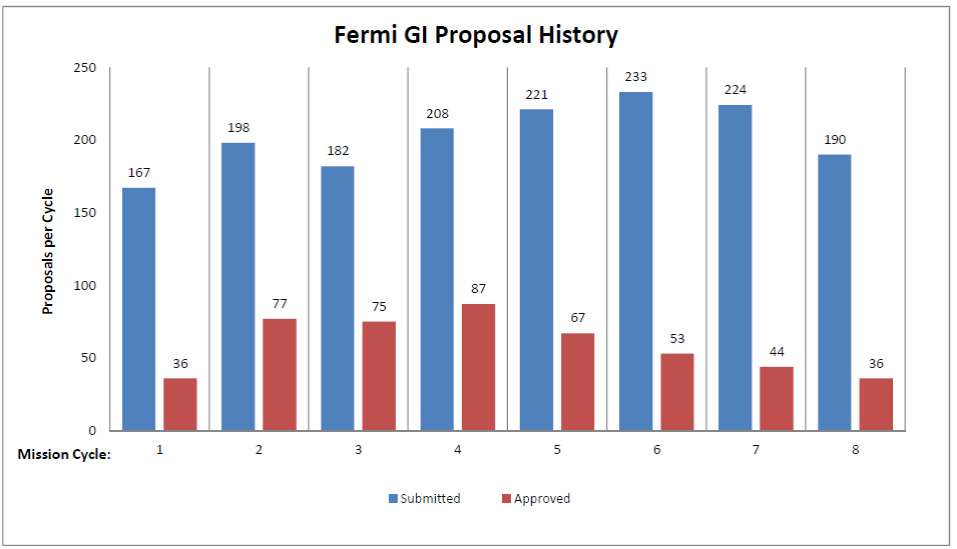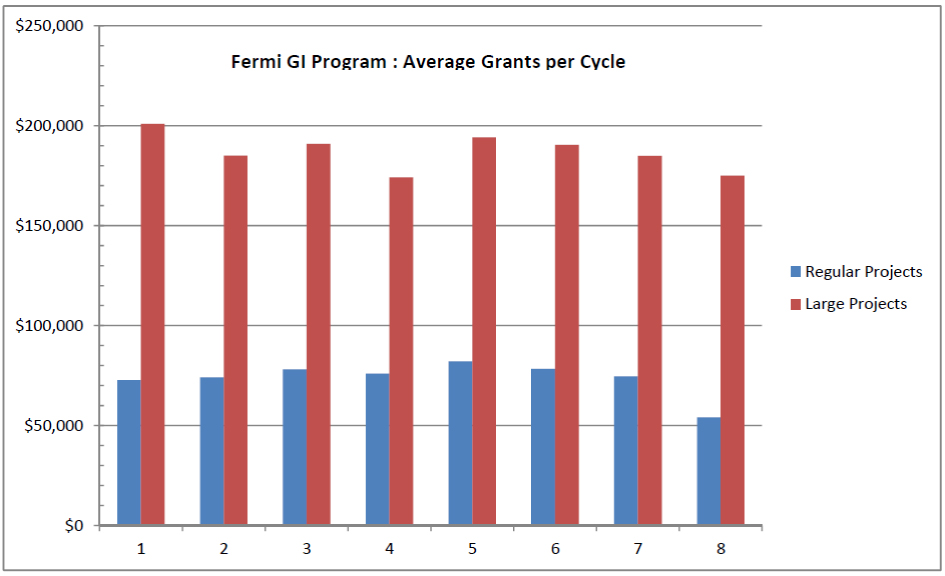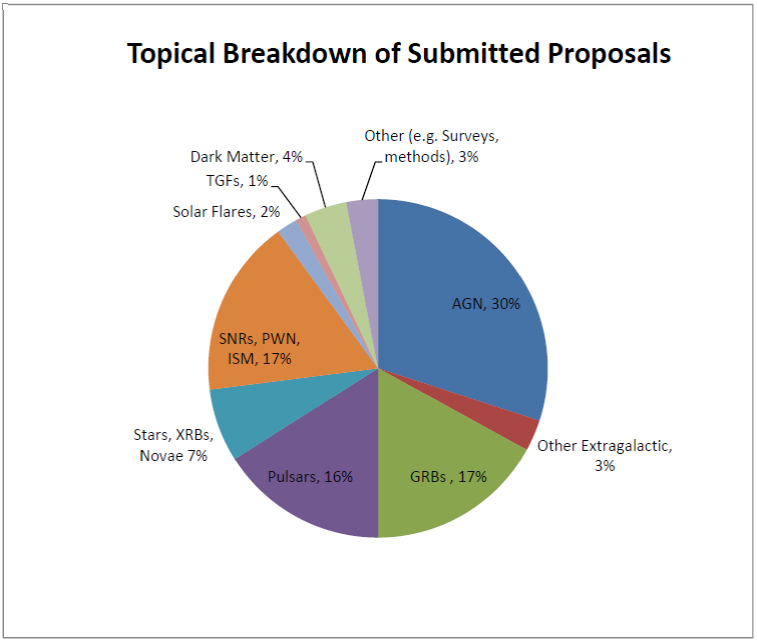Fermi Cycle-8 Guest Investigator Program Summary
The call for Fermi GI proposals is issued annually as part of the NASA ROSES NRA and details are in Appendix D.6 of that document. Typically, proposals are due in the January/February timeframe and each new mission cycle starts in mid August. Since Fermi proposals are predominantly requests for grant support - all Fermi science data products are publicly available promptly following acquisition - the proposal PIs are almost exclusively from US institutions. Nonetheless, a large number of non-US co-Is participated in the program totaling 66 coIs from 19 countries in Cycle 8.
Proposals to participate in the Fermi Cycle-8 GI program were due on January 22, 2015. A total of 190 proposals were received, involving over 348 institutions and 503 individual investigators (PIs and co-Is). These proposals were evaluated through a two stage process. A scientific peer-review was organized and it took place in late March 2015. A total of 42 scientists from 36 institutions participated. That led to 36 selections and thus an overall selection rate of 18% (this statistic does not include 4 Progress Reports requesting continuation of multi-Year Large Projects which were all approved). A second stage review, in which details of funding requests from those selected in the stage-I review, was held in July. The results of this review process and some historical perspective are summarized below.
The number of proposals submitted decreased by about 15% and the number of selections and the acceptance rate continue to decline (see the accompanying table below). The table also gives the selection history of Large and multi-year projects.
| Cycle 1 | Cycle 2 | Cycle 3 | Cycle 4 | Cycle 5 | Cycle 6 | Cycle 7 | Cycle 8 | |
|---|---|---|---|---|---|---|---|---|
| Submitted | 167 | 198 | 182 | 208 | 221 | 233 | 224 | 190 |
| Approved | 36 | 77 | 75 | 87 | 67 | 53 | 44 | 36 |
| Large | 8 | 3 | 2 | 3 | 2 | 1 | 3 | 2 |
| multi-year | NA | NA | NA | 30/72 | 22/80 | 2/88 | 9/71 | 3/61 |
| Oversubscription | 4.6 | 2.6 | 2.4 | 2.4 | 3.3 | 4.4 | 5.1 | 5.3 |
| $ Over subscription | 3.9 | 2.5 | 2.4 | 2.4 | 3.5 | 4.9 | 4.7 | 4.6 |
The average grant amount per cycle, both for regular projects and Large Program awards, remained fairly constant during Cycles 1-7, but has decreased in Cycle 8. This was in part a result of recommendations resulting from the 2014 NASA MO&DA Senior Review.
A summary of the received and selected proposals is depicted graphically below. To a large extent, for the breakdowns by topical categories and proposal types, the relative proportions of submitted and selected proposals are similar. Thus, selection is mainly driven by proposal pressure.
There are a few exceptions: the proportion of investigations of Galactic extended sources; SNRs, PWNs, ISM/CRs, significantly decreased (17% submitted, 3% selected). In the charts showing breakdown by Proposal Type the most notable difference is in fraction of corrleted-observating proposals. Note that no apriori quotas are imposed on the numbers or fractions of any proposal type or topical category.
Fermi science is broad in scope as can be seen from these charts. A list of the title, abstracts, and principle investigators of selected Cycle-8 programs is available elsewhere on this web site.
Proposals involving the Fermi joint observing programs with NRAO, NOAO, VERITAS, Arecibo and INTEGRAL are summarized in the table appended below. Radio-loud AGN and rotation-powered pulsars are the predominant topics that comprise the Fermi joint observation programs (although again, the program is entirely open with no a priori quotas). Participants may also request time on a NASA sponsored super-computing facility as part of their GI proposals.
| Joint Program Summary | ||||
|---|---|---|---|---|
| Program | Requests | Awards | ||
| Proposals | Hours | Proposals | Hours | |
| NRAO | 10 | 200 | 3 | 60 |
| NOAO | 4 | 441 | 0 | 0 |
| VERITA | 10 | 241 | 2 | 54 |
| INTEGRAL | 1 | 28 | 0 | 0 |
| Arecibo | 3 | 122 | 0 | 0 |
| High End Computing | 3 | - | 0 | - |
Input on how to best organize and implement the Fermi GI program is provided by the Fermi Users Group. Please feel free to contact a member of the users group if you have any suggestion on how the GI program might be improved going into the future.









